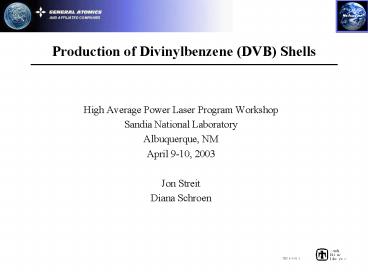Production of Divinylbenzene DVB Shells - PowerPoint PPT Presentation
1 / 15
Title:
Production of Divinylbenzene DVB Shells
Description:
Problem: Difficult Imaging, Cracking, Time Consuming ... Future Work. Continue to study agitation and density matching as a means to reduce ... – PowerPoint PPT presentation
Number of Views:57
Avg rating:3.0/5.0
Title: Production of Divinylbenzene DVB Shells
1
Production of Divinylbenzene (DVB) Shells
- High Average Power Laser Program Workshop
- Sandia National Laboratory
- Albuquerque, NM
- April 9-10, 2003
- Jon Streit
- Diana Schroen
2
Review
- 4 mm Diameter Foam Shell
- 300 micron DVB Foam Wall
- CH Polymer
- 1-3 Micron Cell Size
- 20 - 120 mg/cc
- 1 micron Carbon Overcoat
- Inner Water Phase
- Organic Phase
- Stripping Phase
- Progress
- Assembled droplet generator for shell production.
- Fabricated approximately 4 mm diameter shells
with 300 µm walls at 100 mg/cc. - Overcoated shells with a poly(vinyl phenol)
overcoat. - Problems include nonconcentricity, cracking.
3
Shell Production Flow
- Shell production work is occurring in four areas
simultaneously with process scale-up in mind
Formation / Gelation
- Problem Shell Nonconcentricity
- Possible Solution Density Matching, Agitation
Characterization
- Problem Difficult Imaging, Cracking, Time
Consuming - Possible Solution Index Match, On-site,
Automate
Overcoating
- Problem Time consuming, Need surface
characterization - Possible Solution Automate, Perform SEM
analysis
Supercritical Drying
- Problem Overcoated shells crack
- Possible Solution Slow CO2 bleed off
4
Agitation
- Shell deformation during gelation has previously
been shown to increase shell concentricity - Shell path during gelation has been altered from
the original configuration - Flask RPM has also been increased to intensify
shell deformation - Shells have been made to study the effect of
agitation, but have not yet been characterized
Bottom view of shell path in full flask
Bottom view of shell path in 2/3 full flask
5
Density Matching / Initiator
- The density of the inner water phase and the
organic phase change with temperature this can
affect shell nonconcentricity - To minimize this effect a low temperature
initiator, V-70, was used. - Shells made with pre-polymerization but at 60C
were tacky and translucent. - Shells made without pre-polymerization tended
to agglomerate. - Benefit of V-70 is not apparent.
6
Characterization
- To increase the rate of data return and to help
decrease shell cracking, an on-site
characterization technique has been developed.
- Two orthogonal images are taken to calculate
dimensions - Benzyl Salicylate is a better index match making
characterization easier and more accurate. - DBP Dibutyl Phthalate, IPA Isopropyl Alcohol,
BSA Benzyl Salicylate
7
Characterization Equipment
- Shells are placed in an optical cell and
positioned on stage of assembly station to
collect images. Effective, but time consuming. - Shell images analyzed using Image Pro Plus
Software - Data exported to Excel.
8
Shell Images 16 Nonconcentricity
- Top View
Side View
Note Color variation is due to differing
lighting conditions.
9
Shell Images 3 Nonconcentricity
- Top View
Side View
Note Color variation is due to differing
lighting conditions.
10
Nonconcentricity Wall Thickness
- Nonconcentricity (4Pi Offset) / (Average
Wall Thickness) x 100 - 4Pi Offset is the greatest distance between the
centers of the inner and outer spheres. - Example 16 Nonconcentricity
- Example 3 Nonconcentricity
11
Rapid Characterization Concept
- A concept for rapid shell characterization is
being developed. - Shell that have been exchanged into BSA flow
through a tube to an optical cell on the assembly
station. - Images are analyzed and shells are sorted as Pass
or Fail upon exiting the cell.
12
Overcoating
- A few areas need to be studied in the overcoating
process - Does reducing the concentration of the acid
chloride slow the reaction and result in an
improved surface finish? - A thicker overcoat can be created using a lower
molecular with PVP. Would this result in the
overcoat growing into the foam? - BSA Benzyl Salicylate, 4CT 4-Chlorotoluene,
ACl Isophthaloyl Dichloride, PVP Poly(4-vinyl
phenol)
13
Overcoating Concept
- Shells are currently manually overcoated. A
concept is being developed to wash shells in a
tube and overcoat them as they flow through a
coil.
Shell containing Organic Solution of Acid
Chloride
Overcoated Shell
14
Supercritical Drying
- We use a semi-automated CO2 pressure vessel.
- While supercritical drying of non-overcoated
shells has been successful, drying of overcoated
shells has been problematic - shells have
ruptured. - Bleeding off CO2 over a longer period of time may
eliminate the problem. - Rupture does demonstrate the seal provided by the
overcoat.
15
Future Work
- Continue to study agitation and density matching
as a means to reduce nonconcentricity. - Investigate methods to streamline the
characterization process. - Characterize shells produced in agitation study.
- Continue to study and streamline the overcoating
process and begin to characterize the overcoat. - Explore methods to eliminate shell rupture
problem during supercritical drying.































